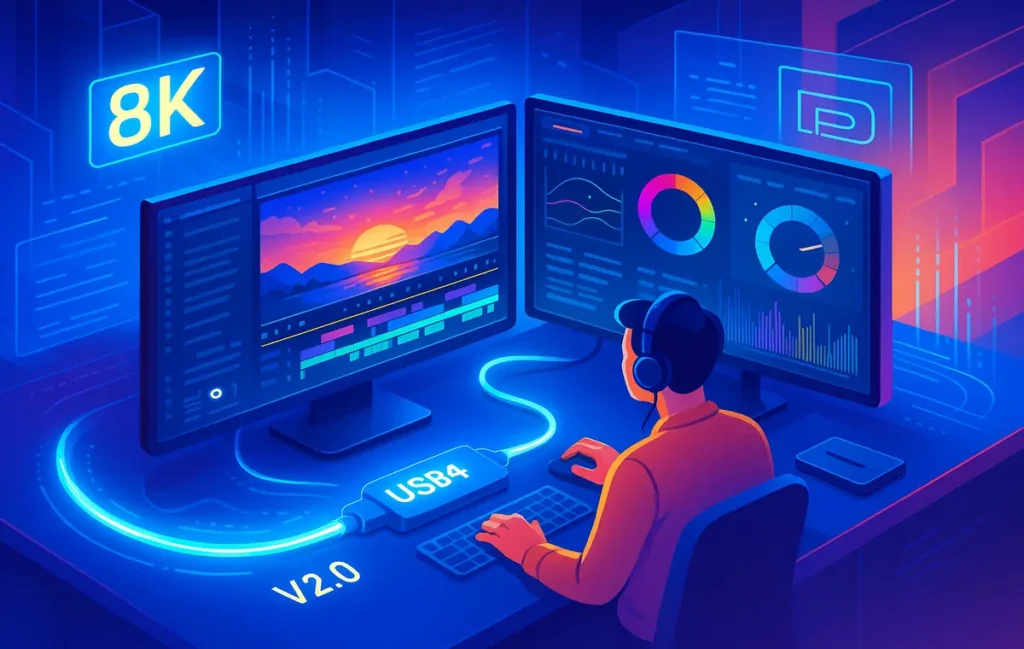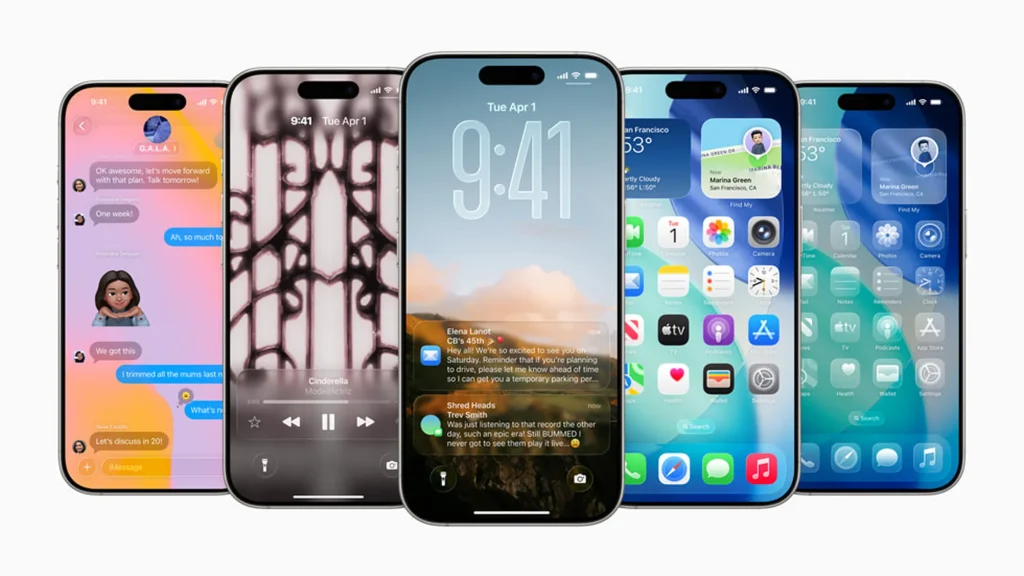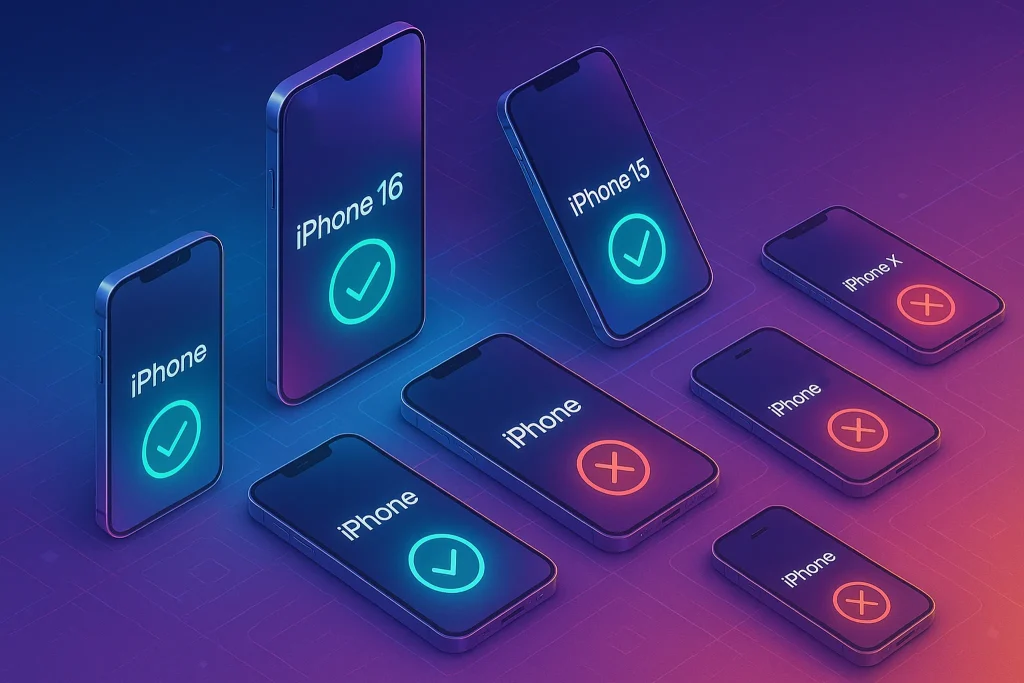🎯 Intro: More Than Just Numbers
When you see “USB4 v2.0” or “DisplayPort 2.1,” it’s tempting to treat them as yet another round of tech jargon. But for creators, these standards mean something more tangible: faster transfers of massive video files, buttery-smooth 8K editing, and the freedom to set up multi-monitor workstations without juggling adapters.
In practical terms, USB4 v2.0 doubles the available bandwidth to a staggering 80Gbps, while DisplayPort 2.1 ensures creators can finally drive multiple ultra-high-resolution displays over a single cable. Whether you’re a filmmaker editing RAW footage, a 3D designer pushing external GPUs, or a YouTube creator experimenting with multi-cam editing, these upgrades aren’t just incremental—they’re workflow-defining.
💡 Nerd Tip: Think of USB4 v2.0 and DP 2.1 as highways built for creator workloads. If you’re already hitting traffic jams on your current setup, it’s time to look at these new lanes.
🔍 What’s New in USB4 v2.0
USB4 v2.0 is more than just a speed bump—it’s a fundamental overhaul of how creators move data. The jump from 40Gbps in USB4 v1 to 80Gbps in v2 might sound like a spec-sheet brag, but in real use, it means transferring a 200GB project file in less than half the time.
The magic lies in its dual-lane operation. Unlike older USB or even Thunderbolt standards, USB4 v2.0 intelligently negotiates bandwidth allocation across lanes, ensuring stability even under mixed workloads. This matters when you’re both transferring footage to an external SSD and powering an external monitor simultaneously.
Another creator-friendly advantage is backward compatibility. USB4 v2.0 maintains seamless interoperability with Thunderbolt 3, Thunderbolt 4, and legacy USB-C devices. That means you won’t need to replace your entire ecosystem overnight—your favorite SSD, capture card, or microphone interface will still plug right in.
And for those working with external GPUs, USB4 v2.0 finally unlocks smoother rendering pipelines. Where bottlenecks once crippled real-time 3D previews, the extra bandwidth ensures external GPU enclosures can keep pace with modern RTX or Radeon cards.
💡 Nerd Tip: If you’re still on older USB-C hubs, watch out. Many cheap hubs don’t certify for USB4 v2.0 speeds, which can throttle your transfers. Always check for official USB-IF certification.
⚡ DisplayPort 2.1 Explained
While USB4 v2.0 handles the data highway, DisplayPort 2.1 is the visual fuel. The headline feature is support for resolutions up to 8K at high refresh rates and even 10K in certain configurations. For creators who live in DaVinci Resolve or Adobe Premiere, the ability to preview edits natively in 8K without dropped frames is transformative.
More importantly, DisplayPort 2.1 integrates Variable Refresh Rate (VRR), a technology often discussed in the gaming world but just as relevant for creators. Imagine editing animations or VFX where every frame is rendered differently—the VRR ensures your display keeps up with the dynamic workload, minimizing tearing or ghosting.
DP 2.1 also enables multi-monitor setups over a single cable. Instead of chaining multiple adapters or relying on finicky splitters, you can now run multiple high-res monitors from one port. For creators who use dual-screen productivity setups—like a laptop paired with a portable USB-C monitor—this is an immediate upgrade. (If you’re curious about how portable monitors already boost workflows, check out our deep dive on Portable Monitors and Other Underrated Productivity Gadgets).
💡 Nerd Tip: Don’t confuse HDMI 2.1 with DP 2.1. HDMI may dominate in TVs and consoles, but DisplayPort remains the creator’s choice for raw bandwidth and daisy-chaining monitors.
🛠️ Why Creators Should Care
At first glance, you might think these standards only benefit gamers or enterprise setups. But the reality is that creators stand to gain the most. Editing uncompressed 8K RAW video requires not just a powerful CPU and GPU, but also a data pipeline that won’t choke. USB4 v2.0 provides that pipeline.
The multi-monitor capabilities of DP 2.1 also make creator life dramatically simpler. Instead of plugging in bulky docks or relying on laggy wireless display solutions, you can now connect multiple displays with a single cable. This matters when juggling reference monitors, color grading panels, or secondary editing screens.
There’s also a strong case for future-proofing. If you’re investing in new gear in 2025 and beyond, buying into these standards ensures you won’t be bottlenecked when 8K workflows become mainstream. As tools like the Best AI Editing Tools for YouTube Creators grow more demanding, the hardware that powers them must keep pace.
💡 Nerd Tip: Think about your next laptop purchase. If you’re planning to edit or stream professionally, ensure it carries official support for USB4 v2.0 and DP 2.1. Many 2025 models are adding them, but not all.
🚀 Real-World Use Cases
Consider the videographer editing a short film in 8K ProRes RAW. With USB4 v2.0, transferring hundreds of gigabytes of footage from camera cards to external SSDs no longer eats up precious hours.
Streamers running multi-monitor setups can now feed game capture, chat overlays, and editing software across two or three displays—without introducing input lag. For photographers working with massive RAW batches, DP 2.1 ensures previews render sharply even at ultra-high resolutions, eliminating guesswork in color grading.
3D designers, meanwhile, finally benefit from external GPU enclosures that truly perform. Instead of stuttering viewport navigation in Blender or Maya, the added bandwidth makes offloading rendering tasks feasible without sacrificing interactivity.
And for creators always on the go, combining a USB4 v2.0 laptop with a Portable USB-C Monitor means working from a coffee shop with a dual-screen setup that actually feels like a studio.
⚠️ Challenges & Solutions
The biggest hurdle is adoption speed. While the standards are finalized, most mainstream devices still ship with USB4 v1 and DP 1.4. Expect widespread USB4 v2.0 laptops to appear gradually in late 2025 and 2026.
Another challenge is certification. Many cables and hubs on the market still claim high bandwidth without being officially tested. Using uncertified gear can throttle speeds back to USB 3.2 levels. The solution? Only buy certified devices—even if they cost slightly more.
Cost is another concern. Early DP 2.1 monitors and USB4 v2.0 hubs come at a premium. But as with every tech cycle, prices will normalize as adoption grows. For now, evaluate whether your current workflow justifies the upgrade. For example, if you’re editing 4K content and not struggling, you may not need to rush. But if you’re working at the edge of what your setup allows, investing early could be a competitive advantage.
💡 Nerd Tip: Check if your cables are “active” or “passive.” For full 80Gbps speeds, some setups require active cables—especially beyond two meters.
⚡ Upgrade Your Creator Setup
Don’t let outdated ports throttle your creativity. Certified USB4 v2.0 hubs, active cables, and DisplayPort 2.1 monitors ensure your workflow runs at full speed.
📊 USB4 v2.0 vs Thunderbolt 5 vs DisplayPort 2.1 vs HDMI 2.1
Creators often wonder which port or standard they should prioritize. Each has strengths, but their roles differ.
| Feature | USB4 v2.0 | Thunderbolt 5 | DisplayPort 2.1 | HDMI 2.1 |
|---|---|---|---|---|
| Bandwidth | 80 Gbps | 80–120 Gbps (with dual mode) | 77 Gbps effective video | 48 Gbps |
| Best Use Case | File transfers, external GPUs, docks | High-end creator laptops, pro docks | Multi-monitor setups, 8K/10K displays | TVs, consoles, home theaters |
| Monitor Support | Yes (via Alt Mode) | Yes (native + Alt Mode) | Multi-monitor, daisy chain | Limited multi-monitor |
| Compatibility | Backward with USB-C/Thunderbolt 3/4 | Limited to new Intel devices | Backward with DP 1.4/2.0 | Widely adopted in TVs |
| Creator Relevance | External SSDs, eGPUs, all-in-one ports | Premium setups, pro workflows | 8K video editing, VRR, dual displays | Consumer media, streaming |
💡 Nerd Tip: If you’re building a new setup, USB4 v2.0 + DP 2.1 together cover nearly all creator needs. HDMI 2.1 is still handy for external TVs or projectors, but it’s no longer the king of creator workflows.
📈 Benchmarks & Real-World Numbers
Let’s translate specs into time saved. Imagine you’re transferring raw 8K footage from a camera card:
-
A 200GB file on USB4 v1 (40Gbps) might take around 80–90 seconds with an SSD.
-
On USB4 v2.0 (80Gbps), that same transfer could finish in under 45 seconds.
-
Using an older USB 3.2 Gen 2 (10Gbps) setup? You’d be waiting over six minutes.
For display bandwidth, DisplayPort 2.1 can carry 77 Gbps of video bandwidth, enabling uncompressed 8K at 60Hz with HDR. HDMI 2.1 maxes out at 48 Gbps, which often forces compression when driving high-refresh-rate monitors.
💡 Nerd Tip: Numbers don’t just look good on paper. If your project timeline is tight, shaving five minutes off every transfer compounds into hours saved every week.
🔮 Future Outlook: What’s Next Beyond USB4 v2.0 & DP 2.1
The tech cycle never stops. While USB4 v2.0 and DP 2.1 are the stars of 2025–2026, we’re already seeing early hints of what comes next.
Thunderbolt 5 promises adaptive bandwidth scaling up to 120 Gbps in burst mode—ideal for external GPU use and multi-monitor editing. It’s expected to co-exist with USB4 v2.0 rather than replace it, much like Thunderbolt 3 did alongside USB-C.
On the display side, DisplayPort 2.2 may emerge with better compression algorithms (DSC 2.x) for even smoother multi-monitor scaling at 10K and beyond. For creators, this means VR, AR, and immersive 3D environments will become more seamless.
💡 Nerd Tip: Don’t feel pressured to upgrade every cycle. Instead, plan your purchases around your workflow lifespan. If you upgrade gear every 3–4 years, aim for the standards that will still be relevant when you next refresh.
👤 Creator Personas: Who Benefits Most?
Different types of creators experience these upgrades in different ways:
-
The YouTuber with Multi-Cam Edits
Imagine syncing three 4K or 8K camera feeds. With USB4 v2.0 external drives, offloading raw footage becomes nearly instant, while DP 2.1 allows previewing the timeline on dual high-res monitors with zero lag. -
The 3D Artist
Using Blender or Maya, external GPUs connected over USB4 v2.0 can now handle real-time viewport rendering. Instead of stutters, every camera orbit feels smooth—like working on a native desktop GPU. -
The Music Producer
Producers using DAWs with complex plugin chains benefit from multiple displays showing their mixing console and MIDI editor side by side. DP 2.1 reduces latency and keeps the setup clean with one cable. -
The Photographer
For photographers managing thousands of RAWs, USB4 v2.0 ensures fast batch transfers, while DP 2.1 guarantees accurate previews across dual calibrated monitors.
💡 Nerd Tip: Identify your own persona. If your bottleneck is file transfer, USB4 v2.0 should be your first priority. If it’s screen real estate, DP 2.1 is your upgrade path.
🔗 Stronger Internal Linking for Deeper Network
We already linked to monitors and gadgets, but let’s enrich the semantic web further:
When discussing workflow tools, naturally reference Video Editing Pro Tips for YouTube Creators. This helps readers bridge the gap between hardware and editing skills.
In sections about mobile creators working on the go, anchor to Best Smartphone Accessories for Content Creators to show how creators can maximize every device in their toolkit.
And in the gear recommendations section, connecting to Top Gadgets for Content Creators builds authority around NerdChips’ role as a gear guide, not just a news outlet.
💡 Nerd Tip: Internal links aren’t just for SEO—they guide readers into a rabbit hole of insights, keeping them in your content ecosystem longer.
📬 Want More Smart Tech Insights?
Join our newsletter and get weekly deep dives into future tech, AI tools, and creator gear—straight to your inbox. No noise, just value.
🔐 100% privacy. Pure creator-focused content tips from NerdChips.
🧠 Nerd Verdict
USB4 v2.0 and DisplayPort 2.1 aren’t just technical evolutions—they’re the backbone of the next era of creative work. Together, they enable true 8K workflows, seamless multi-monitor setups, and external GPU performance that finally feels native.
For creators, the question isn’t whether these standards matter—it’s when you should adopt them. If your current setup bottlenecks your workflow, the upgrade will feel like night and day. If not, you can wait until prices settle. Either way, this is the direction the industry is heading, and NerdChips believes creators who adopt early gain a lasting competitive edge.
❓ FAQ: Nerds Ask, We Answer
💬 Would You Bite?
Would you invest now in USB4 v2.0 and DP 2.1 gear to stay ahead, or wait until prices drop and adoption becomes mainstream?
Crafted by NerdChips for creators who demand speed, clarity, and future-proof workflows.



